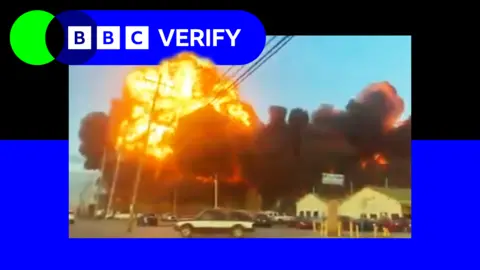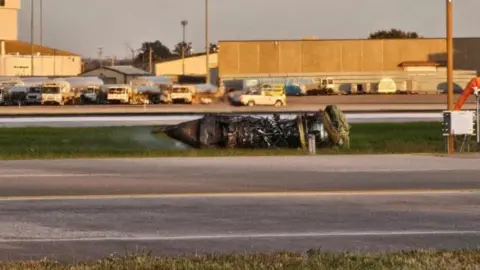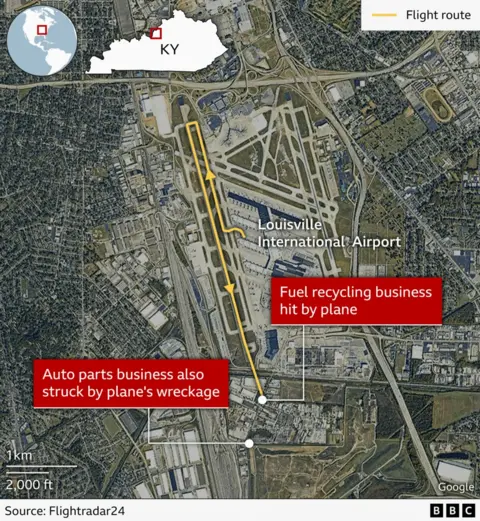Jake Horton, Joshua Cheetham and Matt MurphyTry the BBC
 BBC
BBCAt least nine people were killed and 11 others injured after a cargo plane crashed while taking off from an international airport in Louisville, Kentucky, on Tuesday night.
Aviation experts who spoke to the BBC confirmed that the plane went down after one engine failed and the other appeared to have been damaged during takeoff.
It is not clear what caused the plane to crash, which caused a large fireball to explode after it failed to take off from the runway. The footage shows fire engulfing a wing of the plane as it tries to take off, possibly spreading through the plane and causing something on the ground to explode.
It is clear that the 38,000 gallons (144,000 liters) of fuel on board the MD-11 jet needed for the flight quickly spread to the buildings ahead of the runway and burned for several hours.
VBC Verify analyzed the footage that emerged during the night in the piece to piece together how the crash unfolded.
How did it start?
UPS uses Louisville Ali International Airport as a distribution hub for its global operations and was flying to Hawaulu in Hawaii when the cargo plane attempted to take off.
Data from the tracking website flachradar24 shows the plane started taxiing on the 17r runway around 17:15 local time (22:15 GMT) and managed to reach a top speed of 214mph (344KH (H).
But the proven footage shows that when the plane arrived at this speed a fire completely burned the left wing and the planes failed to gain full blast before the massive explosion.
Officials issued a containment measure to local residents and scrambled hundreds of firefighters to the area.
Governor Andy Beshear confirmed the details seen on CCTV footage showing the planes just flying over the ground before a bright flash engulfed the plane. It can then be seen hitting the ground as a huge fireball that explodes around it minutes into its journey.
Authenticated clips taken by motorists on a nearby highway showed flames shooting into the sky while videos later showed smoke billowing from the scene.
Aerial images broadcast by local media showed debris washing down the road and landing on the roofs of at least two local businesses.
What caused the crash?
The air traffic control communications examined by VBC Verify were largely garbotted and full of interference to prevent meaningful conversation about the crash from being heard.
But analysts who spoke to BBC Verify suggested that a dramatic failure of two of the engines may have been responsible for the disaster.
The MD-11 transport plane uses three engines. Two are worn under the wings, and the third is built into the tail at the base of the vertical stabilizer.

The footage verified by VYC Verify shows an explosion of an explosion on the left wing of the plane, which is then inserted to the left as it tries to gain lift and take off.
Two experts independently suggested the left engine may have detached from the plane after suffering from a mechanical or structural failure.
Confidential images taken after the crash show a charred engine sitting on the grass next to the runway at Louisville International Airport.
Terry Tozer, a retired airline pilot and aviation safety expert, told the BBC that it was “almost unheard of” for an engine to fly so badly.

He mentioned the 1979 American Airlines Flight 191 disaster, where 273 people died after the plane’s engine went off while taking off from Chicago’s O’Hare International Airport. Parts of the engine were damaged when the plane replaced them, but Mr. Tozer said it was too early to say whether a similar fault caused the engine to fail the M-11 engine.
Mr. Tozer said the cargo plane could fly on only two engines but the fire damage to the left wing likely caused the loss of the third engine.
“In such a catastrophic event we don’t know what other damage was done to the engine,” he said.

Marco Chan, a senior lecturer in Aviation operations at Buckinghamshire New University, said the footage showed a damaged smokestack. The damage may have occurred as it was struck by debris from the fire and the engine detaching.
“The top engine that emits a puff of smoke can be seen almost immediately afterwards,” said Mr. Chan. “Leaving only the right propulsion engine, creating a serious power imbalance and leaving the planes unable to reach altitude.
“We lost both engines during take-off with a third of the power and little chance of continuing the flight, especially at maximum stall,” added Mr. Chan.
Why does the crash cause such damage?
Footage from the aftermath of the crash shows a scene of complete chaos with several fires burning in a huge swath of a huge swath of the site and smoke billowing into the sky.
The plane, which is 34 years old and used as a passenger plane until 2006, has completed a return journey from Louisville in Marthore, Maryland.
It is not confirmed what was on board the cargo flight for Hawaii, although the officials said that the plane did not carry any satisfactory risk of contamination.
“This is a Long-Haul Cargo Flight from Louisville to Honolulu, so the MD-11 carries a lot of jet fuel,” Mr. Chan said. “That heavy fuel load not only reduced performance but also explained the large fireball seen after the crash.”
Officials told reporters that the planes were carrying 38,000 gallons (144,000 liters) of fuel for the long journey when they broke down. The explosion was likely amplified on the ground because the plane was driven into a fuel recycling business next to the airport.
Mr. Chan said that the investigators will focus on how the first fire started, and “If the yabris hit the center of the machine with a paper with a paper. He added: “The weather conditions are calm and clear, so environmental factors are unlikely.”
The National Transportation Security Board (NSTB) has sent a team to the site and will now lead the investigation into the causes of the crash, although it may take up to two years.
Additional reporting by Emma Pengebel, kayleen Devlin and Paul Brown.



